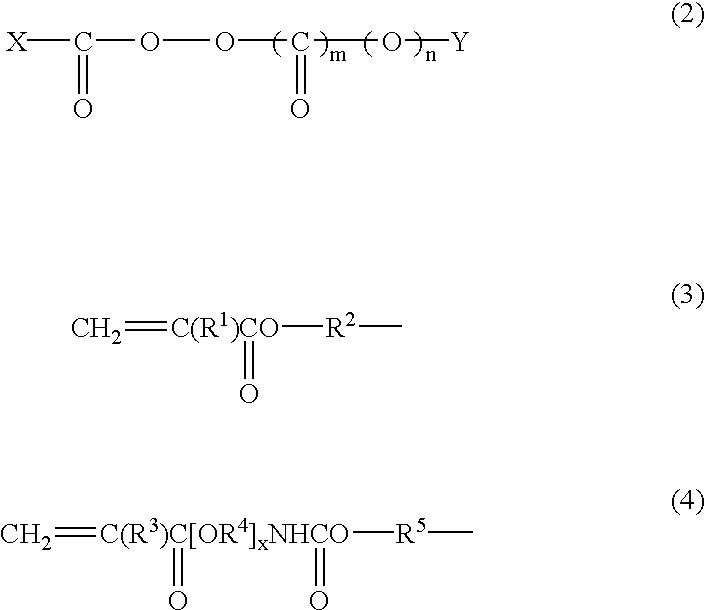Thermopolymerizable composition for battery use
a technology of polymer electrolyte and composition, which is applied in the field of thermopolymerizable composition for solid polymer electrolyte, can solve the problems of long-term use and reliability, high risk of solution leakage outside the capacitor, and high cost, and achieves excellent ionic conductivity, good curability, and sufficient strength
- Summary
- Abstract
- Description
- Claims
- Application Information
AI Technical Summary
Benefits of technology
Problems solved by technology
Method used
Image
Examples
example 2
Preparation of Thermopolymerizable Composition
Diethyl carbonate (DEC) (5.0 g) with Compound 3 (1.0 g), ethylene carbonate (EC) (2.0 g), LiPF.sub.6 (1.00 g), 2,4-diphenyl-4-methyl-1-pentene (polymerization retarder, NOFMER MSD, trade name, produced by NOF Corporation) (1.8 mg) and t-hexylperoxy pivalate (PERHEXYL PV, trade name, produced by NOF Corporation) (18 mg) as a thermopolymerization initiator were well mixed in an argon atmosphere to obtain a polymerizable composition for solid polymer electrolyte.
This composition was interposed between two sheets of calcium fluoride plates (diameter: 2 mm, thickness: 1 mm) in an argon atmosphere to prepare a cell for the measurement of infrared absorption spectrum. At this time, in order to secure a clearance, a 5 .mu.m-thick polyimide film formwork was used. This cell was set to a hot stage with a heat regulator (HOT STAGE Model FP82, manufactured by Metler) and while heating the cell using an FT-IR apparatus (Model BALOER 3, manufactured b...
example 3
Preparation of Thermopolymerizable Composition
Diethyl carbonate (DEC) (5.0 g) with Compound 3 (1.0 g), ethylene carbonate (EC) (2.0 g), LiPF.sub.6 (1.00 g), 2,4-di(2-methylphenyl)-4-methyl-1-hexene (1.8 mg) and t-hexylperoxy pivalate (PERHEXYL PV, trade name, produced by NOF Corporation) (45 mg) as a thermopolymerization initiator were well mixed in an argon atmosphere to obtain a polymerizable composition for solid polymer electrolyte.
This composition was interposed between two sheets of calcium fluoride plates (diameter: 2 mm, thickness: 1 mm) in an argon atmosphere to prepare a cell for the measurement of infrared absorption spectrum. At this time, in order to secure a clearance, a 5 .mu.m-thick polyimide film formwork was used. This cell was set to a hot stage with a heat regulator (HOT STAGE Model FP82, manufactured by Metler) and while heating the cell using an FT-IR apparatus (Model BALOER 3, manufactured by Nippon Bunko K. K.), the infrared absorption spectrum was measured. ...
example 4
Preparation of Solid Polymer Electrolyte Film A
Compound 3 (1.0 g), propylene carbonate (PC) (0.8 g), EC (2.2 g), LiPF.sub.6 (0.45 g), polymerization retarder NOFMER MSD (2.5 mg) and t-hexylperoxy pivalate (PERHEXYL PV, trade name, produced by NOF Corporation) (23 mg) as a thermopolymerization initiator were well mixed in an argon atmosphere to obtain a polymerizable composition for solid polymer electrolyte.
To the thus-prepared polymerizable composition for solid polymer electrolyte, aluminum oxide C (produced by Nippon Aerosil K. K., average particle size of secondary particles: about 0.2 .mu.m, specific surface area: about 100 m.sup.2 / g) (0.20 g) as inorganic fine particle was added and mixed while stirring for 5 minutes to obtain milky-white Polymerizable Composition A for solid polymer electrolyte, containing inorganic fine particles.
Composition A was coated on a polypropylene (PP) film in an argon atmosphere to have a thickness of 30 .mu.m and another PP film was covered there...
PUM
| Property | Measurement | Unit |
|---|---|---|
| particle size | aaaaa | aaaaa |
| temperatures | aaaaa | aaaaa |
| temperature | aaaaa | aaaaa |
Abstract
Description
Claims
Application Information
 Login to View More
Login to View More - R&D
- Intellectual Property
- Life Sciences
- Materials
- Tech Scout
- Unparalleled Data Quality
- Higher Quality Content
- 60% Fewer Hallucinations
Browse by: Latest US Patents, China's latest patents, Technical Efficacy Thesaurus, Application Domain, Technology Topic, Popular Technical Reports.
© 2025 PatSnap. All rights reserved.Legal|Privacy policy|Modern Slavery Act Transparency Statement|Sitemap|About US| Contact US: help@patsnap.com



